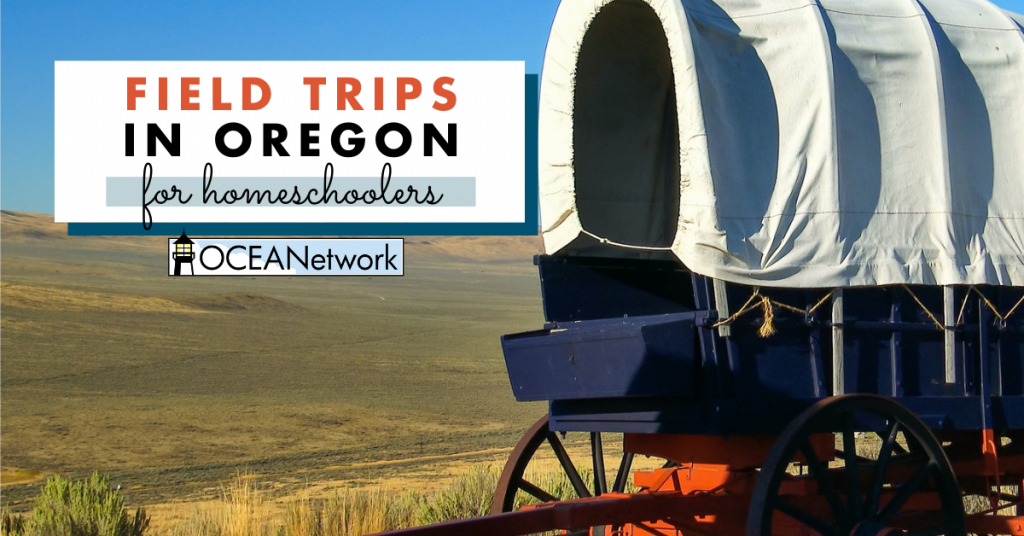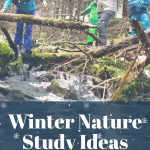Nature studies are one of the hallmarks of the Charlotte Mason approach to home education. She believed, “Let [children] once get in touch with nature and a habit is formed which will be a source of delight and habit through life.”
Even if you don’t follow the Charlotte Mason method, incorporating nature studies into your homeschooling routine can enrich your children’s understanding of the world around them and foster a deeper connection to God who created it all.
“But just ask the animals, and have them teach you; and the birds of the sky, and have them tell you. Or speak to the earth, and have it teach you; and have the fish of the sea tell you. Who among all these does not know that the hand of the Lord has done this, in whose hand is the life of every living thing, and the breath of all mankind?” (Job 12:7-10).

Winter in the Pacific Northwest can be a challenging season to venture outdoors. The cold, wet, and occasionally snowy weather may discourage some, but it also presents unique learning opportunities not readily available during the summer months.
Winter Nature Study Ideas for the Pacific Northwest (Oregon Homeschool Tips)
Here are some ideas to spark your winter nature adventures. Brainstorm ideas of your own. Dig deeper. Be curious. You don’t have to be a nature expert to enjoy it with your children. Make a habit of saying, “Let’s look it up!” Make curiosity and finding out a habit. You’ll be amazed at how fun that is. And you’ll be modeling a life-long love for learning. What a great gift to give your children.
1. Spend a Night Stargazing
On clear winter nights, it’s an adventure to stay up late and go stargazing. Learn about constellations, planets, and the phases of the moon. Plan to catch one of the winter meteor showers: the Leonids, Geminids, Usids, and Quadrantids. (Look them up!)
2. Track the Sun.
Pay attention to where the sun rises or sets on different days of the year. Keep notes, including time of day and compass bearing when it sets. How high is the sun at noon? Which is the shortest day of the year?
3. Observe Trees
Here’s an idea directly from Charlotte Mason, “Children should be made early intimate with the trees, too; should pick out half a dozen trees, oak, elm, ash, beech, in their winter nakedness, and take these to be their year-long friends.” Select a few trees in your area and study them throughout the year. Compare deciduous and evergreen trees. Look at bark texture, leaf shape, seeds, and how they adapt to the changing seasons.
4. Begin Bird Watching
You can attract birds to your yard in the wintertime by setting up bird feeders. Start a bird journal. Draw pictures or take photos of your visitors. Learn to identify the different birds by their songs. Cornel University has created an app called Merlin that you can use to identify a bird by its song.
5. Play in the Rain
Look at raindrops on leaves. Use a magnifying glass. Does the rain coat the surface or form droplets? How are the surfaces of the leaves different? How much rain do you get each day? Use a straight-sided container like a tuna fish can to collect the rain. Measure it at the same time every day. Make a bar graph for the month. And don’t forget to splash in mud puddles.
6. Explore Ice and Snow
Some years we don’t get snow in the Pacific Northwest, but when we do, it’s so fun! Look for frost on leaves and the ground, marveling at their intricate patterns. Catch snowflakes on black cloth or a mitten and look at them with a magnifying glass. Let a straight-sided container fill with snow. Measure how deep it is. Bring it inside and let it melt. Measure how deep the water is.
7. Follow Animal Tracks
Learn to identify animal tracks in the snow or mud. Can you figure out where the animal or bird was going and what it did? You can take pictures if it’s in the snow or make plaster casts of the tracks in the mud to study them more closely.
8. Have a Nature Scavenger Hunt
Scavenger hunts are fun and encourage observation. Make a list of things to find (or find a printable online). You can focus on specific categories, such as mushrooms or objects of a particular color. Have the students check off the items on the list, draw in their journals, or take a picture of the items they find.
9. Bring Nature Indoors
Make art projects with items you have collected on your walks. Press leaves between two pieces of waxed paper (make sure to protect your iron) and hang them in the windows. Make a wreath of pine cones. Fill pinecones with peanut butter and birdseed to use as bird feeders. Make a “flower” arrangement out of twigs.
10. Start a Nature Journal
Embark on these winter adventures with your child by creating nature journals. Fill it with sketches, photographs, pressed leaves, and any fascinating discoveries you make together. Remember, this isn’t about perfection; it’s about capturing cherished memories and fostering a love for the natural world.
Enjoy These Winter Nature Study Ideas!
There are so many more things you can do outside in the winter. Give your curiosity free rein. And give thanks to God for His creation!
“You are worthy, our Lord and God, to receive glory and honor and power, for you created all things, and by your will they were created and have their being” (Revelation 4:11).

Written by Dorothy Karman. Dorothy and her husband, Dick, began homeschooling in 1983. They enjoyed homeschooling both their children through high school and came to realize the importance of Christian home education as a tool for discipling the next generation. They founded OCEANetwork in 1986 to encourage and equip other homeschool families and to protect their homeschool freedoms. They were also founding members of the National Alliance of Christian Home Education Leadership, a national organization that serves state and provincial homeschool leaders from the United States, Canada, and Mexico. In 2016 they were given the Gregg Harris award by HSLDA in recognition of their service as a couple to homeschoolers in Oregon and nationwide. Best of all, their greatest joy is found in being grandparents to four homeschooled grandchildren (so far) who are being brought up in the nurture and admonition of the Lord.
You Might Also Like…
If you loved these winter nature study ideas, you might also like our popular post on Field Trips in Oregon for Homeschoolers!

